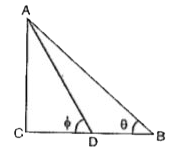If a triangle ABC, D is the mid point of side BC and ∠ADB=θ then cotθ=
b2+c24Δ
b2−c24Δ
b2+c2−a24Δ
none
The correct Answer is:B
To solve the problem, we need to find the value of cotθ in triangle ABC where D is the midpoint of side BC and ∠ADB=θ.
1. Draw the Triangle:
- Start by sketching triangle ABC with points A, B, and C. Mark point D as the midpoint of side BC.
2. Label the Sides:
- Let AB=c, AC=b, and BC=a. Since D is the midpoint of BC, we have BD=DC=a2.
3. Identify the Angles:
- We know that ∠ADB=θ. We need to express cotθ in terms of the sides of the triangle.
4. Use the MN Theorem:
- According to the MN theorem, we can express cotθ as:
cotθ=NcotC−McotBM+N
- Here, M=N=a2 (since D is the midpoint).
5. Substituting Values:
- Substitute M and N into the equation:
cotθ=a2cotC−a2cotBa2+a2=a2(cotC−cotB)a
- This simplifies to:
cotθ=12(cotC−cotB)
6. Expressing Cotangents:
- Recall that:
cotC=cosCsinC,cotB=cosBsinB
- Substitute these into the equation:
cotθ=12(cosCsinC−cosBsinB)
7. Finding Sine and Cosine Values:
- Use the Law of Sines:
asinA=bsinB=csinC=2R
- This gives us:
sinB=b2R,sinC=c2R
8. Substituting Back:
- Substitute sinB and sinC back into the equation for cotθ:
cotθ=12(cosC⋅2Rc−cosB⋅2Rb)
9. Final Expression:
- After simplification, we arrive at:
cotθ=B2−C24Δ
- Where Δ is the area of triangle ABC.
Conclusion:
Thus, the final expression for cotθ is:
cotθ=B2−C24Δ
- Start by sketching triangle ABC with points A, B, and C. Mark point D as the midpoint of side BC.
- Let AB=c, AC=b, and BC=a. Since D is the midpoint of BC, we have BD=DC=a2.
- We know that ∠ADB=θ. We need to express cotθ in terms of the sides of the triangle.
- According to the MN theorem, we can express cotθ as:
cotθ=NcotC−McotBM+N
- Here, M=N=a2 (since D is the midpoint).
- Substitute M and N into the equation:
cotθ=a2cotC−a2cotBa2+a2=a2(cotC−cotB)a
- This simplifies to:
cotθ=12(cotC−cotB)
- Recall that:
cotC=cosCsinC,cotB=cosBsinB
- Substitute these into the equation:
cotθ=12(cosCsinC−cosBsinB)
- Use the Law of Sines:
asinA=bsinB=csinC=2R
- This gives us:
sinB=b2R,sinC=c2R
- Substitute sinB and sinC back into the equation for cotθ:
cotθ=12(cosC⋅2Rc−cosB⋅2Rb)
- After simplification, we arrive at:
cotθ=B2−C24Δ
- Where Δ is the area of triangle ABC.
Thus, the final expression for cotθ is:
cotθ=B2−C24Δ
Topper's Solved these Questions
- PROPERTIES OF TRIANGLES BOOK - ML KHANNACHAPTER - PROPERTIES OF TRIANGLES EXERCISE - Problem Set (2)(TRUE AND FALSE)
2 Videos
- PROPERTIES OF TRIANGLES BOOK - ML KHANNACHAPTER - PROPERTIES OF TRIANGLES EXERCISE - Problem Set (2)(FILL IN THE BLANKS)
3 Videos
- PROPERTIES OF TRIANGLES BOOK - ML KHANNACHAPTER - PROPERTIES OF TRIANGLES EXERCISE - Problem Set (1)(FILL IN THE BLANKS)
10 Videos
- PROGRESSIONS BOOK - ML KHANNACHAPTER - PROGRESSIONS EXERCISE - MISCELLANEOUS EXERCISE (ASSERTION/REASON)
1 Video
- RECTANGULAR CARTESIAN CO-ORDINATE SYSTEM AND THE STRAIGHT LINEBOOK - ML KHANNACHAPTER - RECTANGULAR CARTESIAN CO-ORDINATE SYSTEM AND THE STRAIGHT LINEEXERCISE - COMPREHENSION
11 Videos
Similar Questions
Knowledge Check
In a triangle ABC, D, E, F are the mid-points of the sides BC, CA and AB respectively , the vector →AD is equal to
A→BE+→CFB→BE−→CFC→CF−→BED−→BE−→CFIn a ΔABC,D,E,F are the mid -points of the sides BC, CA and AB respectively, the vector AD is equal to
A−−→BE+−−→CFB−−→BE−−−→CFC−−→CF−−−→BED−−−→BE−−−→CFGiven an equilateral triangle ABC, D, E and F are the mid-points of the sides AB, BC and AC respectively, then the quadrilateral BEFD is exactly a
AsquareBrectangleCparallelogramDrhombus
Suppose P, Q and R are the mid-points of sides of a triangle of area 128cm2. If a triangle ABC is drawn by joining the mid-points of sides of triangle PQR, then what is the area of triangle ABC?
View SolutionIf D is the mid-point of the side BC of a triangle ABC, prove that →AB+→AC=2→AD.
View SolutionD is the mid-point of side AB of the triangle ABC.E is the mid-point of CD and F is the mid-point of AE. Prove that 8× area of (ΔAFD)= area of ΔABC
View SolutionP and Q are respectively the mid-points of sides AB and BC of a triangle ABC and R is the mid-point of AP, show that
ar(ΔPRQ) = 1/2 ar(ΔARC)
View SolutionABC is right angled triangle, right angled at C . D is the midpoint of BC. Then , tanθtanϕ =

View Solution
